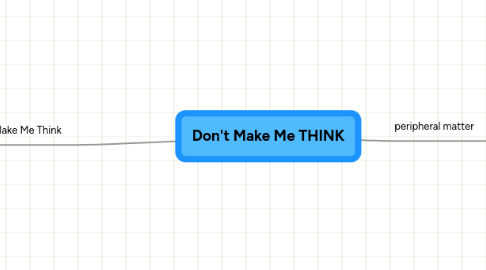
1. ch 1 - Don't Make Me Think
1.1. think
1.1.1. questions
1.1.2. learn what makes users think by noticing what makes you think
1.2. don't think
1.2.1. recognition
1.2.2. users think about task not interface
1.2.2.1. in research, search IS the task
1.2.3. should we read Blink?
1.2.4. self-evident: best
1.2.5. self-explanitory: next best
1.2.5.1. well-chosen names
1.2.5.2. page layout
1.2.5.3. small amounts of text
1.3. names
1.3.1. think: technical, cute, idiosyncratic, ex: "TRELLIS"
1.3.1.1. eschew librarian-speak
1.3.1.2. techical more precise? so what?
1.3.1.3. users don't go to library school
1.3.1.3.1. on the other hand
1.3.2. don't think: obvious, common
1.4. links
1.4.1. think: have to try to be sure
1.4.2. don't think: no need to try to be sure
1.5. search
1.5.1. think
1.5.1.1. extra labels
1.5.1.2. user chooses method
1.5.2. dont' think
1.5.2.1. simple label
1.5.2.2. engine guesses method
1.6. why?
1.6.1. popular misconception
1.6.1.1. users will go elsewhere
1.6.1.1.1. may be no place else to go
1.6.1.1.2. investment in this site
1.6.1.1.3. investment in time already spent
1.6.2. real reason
1.6.2.1. makes everything seem better
1.6.2.2. even successful Web visits are short
1.6.2.3. get the job done in a glance
2. peripheral matter
2.1. contents
2.1.1. recovery
2.1.2. arguments
2.2. 2nd ed
2.2.1. Web site
2.2.2. Web app design book
2.3. forward
2.3.1. change and human nature
2.3.1.1. human needs
2.3.1.2. Shock of the Old
2.4. READ ME FIRST
2.4.1. the stakes
2.4.1.1. businesses
2.4.1.1.1. budgets
2.4.1.1.2. (financial) success of company
2.4.1.2. the library
2.4.1.2.1. what's at stake for us?
2.4.1.2.2. who's our competition?
2.4.1.2.3. do libraries have a future?
2.4.2. if it "seems" time consuming, they won't use it
2.4.3. I want an "It depends" T-shirt
2.4.3.1. there is no one "right" way to design Web sites
